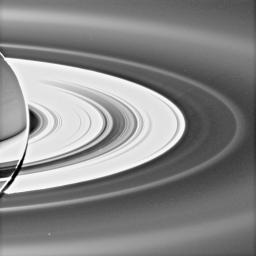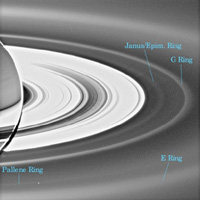
|
Moon-Made Rings
- Click the image above for a larger view
- Full-Res JPEG (508 x 508) (24.9 kB)
- Full-Res TIFF (508 x 508) (258.6 kB)
Caption:
This view, acquired with the sun almost directly behind Saturn, reveals a previously unknown faint ring of material coincident with the orbit of the small moon Pallene.
Another new, diffuse ring seen here was previously announced (see PIA08322 ), and is coincident with the orbits of Saturn's moons Janus and Epimetheus.
This viewing geometry makes microscopic, icy ring particles brighten substantially. Cassini spent nearly 12 hours in Saturn's shadow on Sept. 15, 2006, making observations like this one.
The new Pallene ring is a faint narrow band, about 2,500 kilometers (about 1,550 miles) across, between the E ring and the G ring. The Janus/Epimetheus ring is visible between the G ring and the bright main rings and is about 5,000 kilometer (3,100 miles) wide. A labeled version of this view is also available and shows the locations of these features.
Pallene, discovered by Cassini's imaging cameras earlier in the mission, is 4 kilometers (2.5 miles) across. Pallene orbits Saturn between the moons Mimas and Enceladus. The bright dot in the Pallene ring is not the tiny moon, but rather is a background star.
While it is not unexpected that impact events on Janus, Epimetheus, and Pallene might kick particles off the moons' surfaces and inject them into Saturn orbit, it is, however, surprising that these structures are so well-defined.
The view looks down from about 15 degrees above the dark side of the rings. Some faint spokes can also be spotted in the main rings, made visible by sunlight diffusing through the B ring.
The image was taken in visible light with the Cassini spacecraft wide-angle camera on Sept. 15, 2006, at a distance of approximately 2.2 million kilometers (1.3 million miles) from Saturn and at a Sun-Saturn-spacecraft angle of almost 179 degrees. Image scale is approximately 250 kilometers (155 miles) per pixel.
Background Info:
The Cassini-Huygens mission is a cooperative project of NASA, the European Space Agency and the Italian Space Agency. The Jet Propulsion Laboratory, a division of the California Institute of Technology in Pasadena, manages the mission for NASA's Science Mission Directorate, Washington, D.C. The Cassini orbiter and its two onboard cameras were designed, developed and assembled at JPL. The imaging operations center is based at the Space Science Institute in Boulder, Colo.
For more information about the Cassini-Huygens mission visit http://saturn.jpl.nasa.gov/home/index.cfm . The Cassini imaging team homepage is at http://ciclops.org .
Cataloging Keywords:
| Name | Value | Additional Values |
|---|---|---|
| Target | Saturn Rings | E Ring, Enceladus, Epimetheus, Janus, Mimas, Pallene, Saturn |
| System | Saturn | |
| Target Type | Ring | Planet, Satellite |
| Mission | Cassini-Huygens | |
| Instrument Host | Cassini Orbiter | |
| Host Type | Orbiter | |
| Instrument | Imaging Science Subsystem (ISS) | |
| Detector | Wide Angle Camera | |
| Extra Keywords | Grayscale, Impact, Shadow, Visual | |
| Acquisition Date | ||
| Release Date | 2006-10-11 | |
| Date in Caption | ||
| Image Credit | NASA/JPL/Space Science Institute | |
| Source | photojournal.jpl.nasa.gov/catalog/PIA08328 | |
| Identifier | PIA08328 | |

